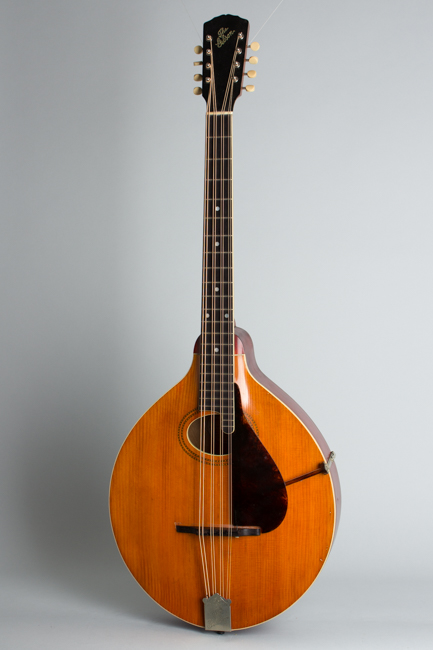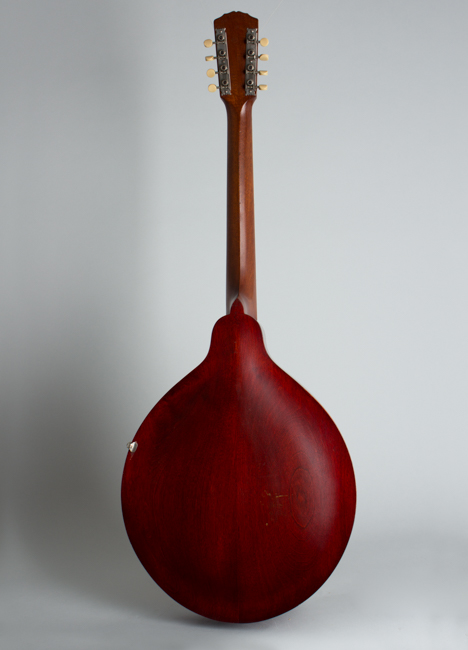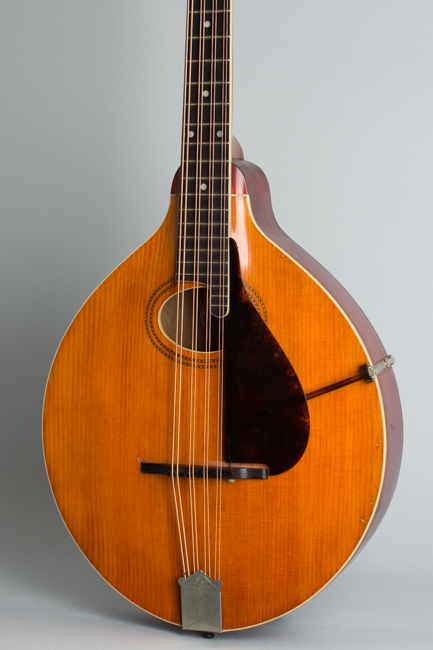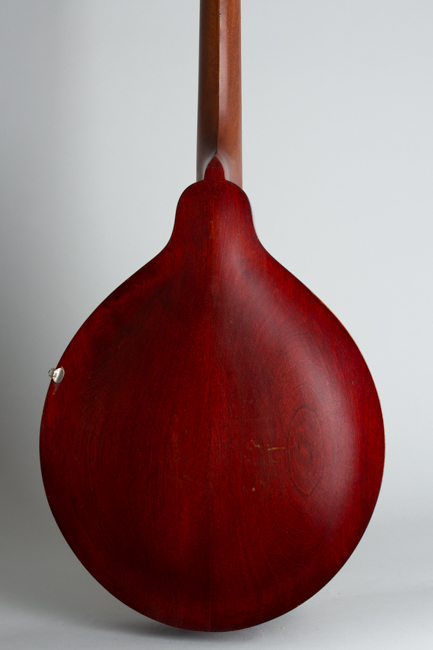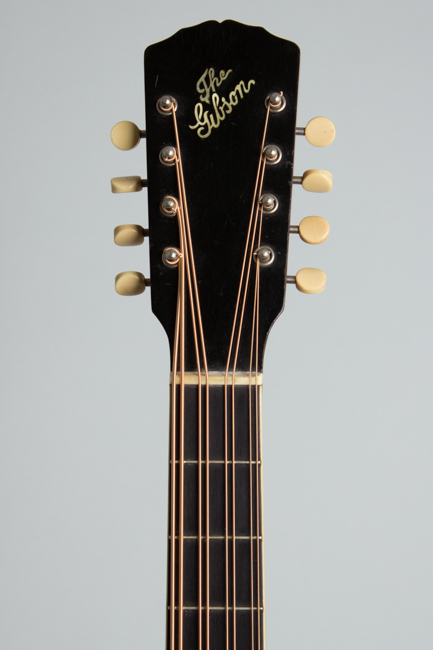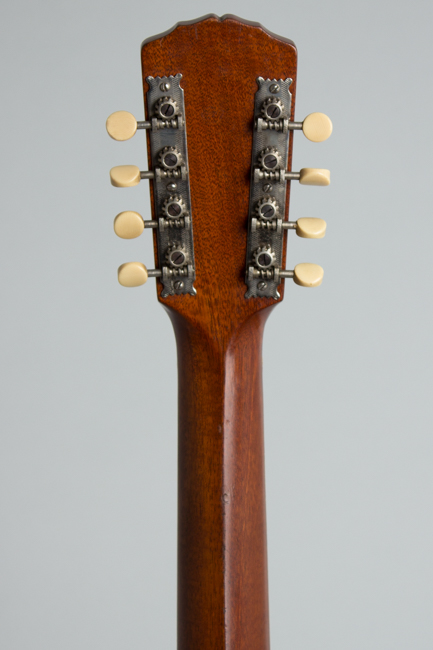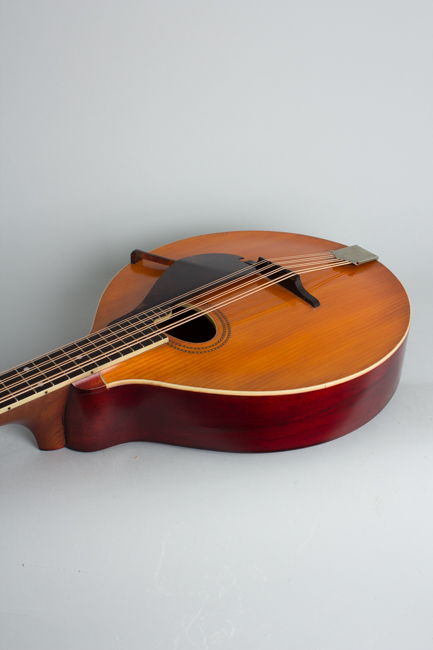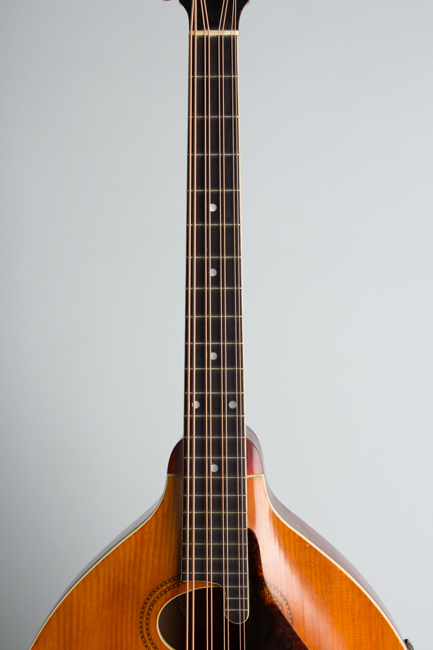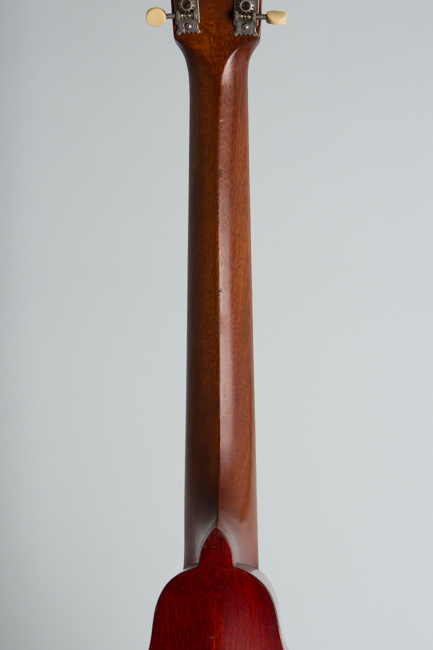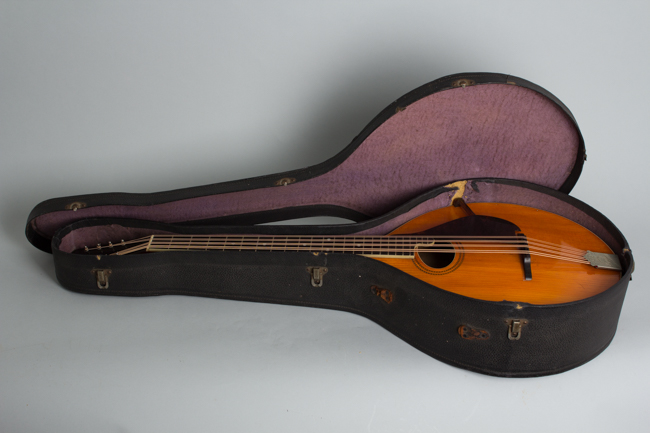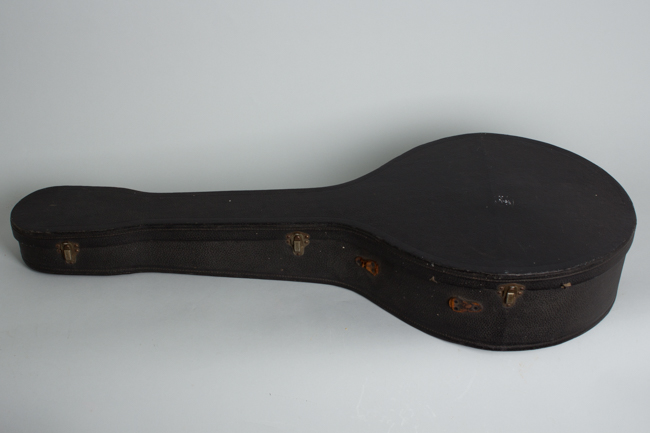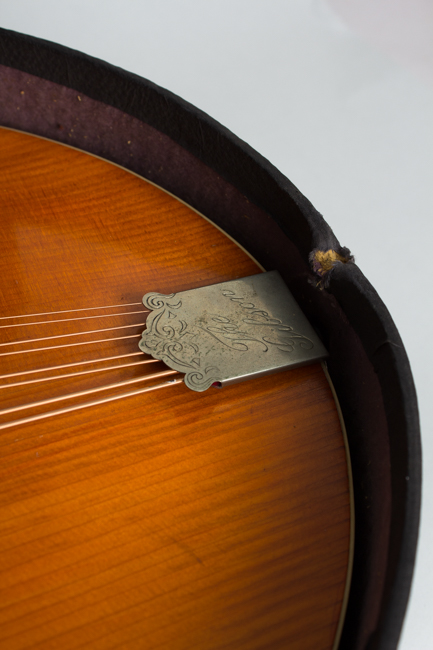Gibson K-1 Carved Top Mandocello (1912)
This item has been sold.
Item # 9802
Prices subject to change without notice.
Gibson K-1 Model Carved Top Mandocello (1912), made in Kalamazoo, Michigan, serial # 16793, natural top, cherry stained back and sides finish, birch back and sides, spruce top; mahogany neck with ebony fingerboard, original black chipboard case.
We feel the Gibson Mandocello is one of the great under-appreciated instruments of the early 20th century. Originally designed for use in 1910s-era mandolin orchestras, these imposing beasts never found a home in any other style of music despite being wonderful and unique-sounding creations.
Double-strung and tuned in fifths starting with the C below the low E on the guitar, the mandocello has an imposing tone and deep resonance quite unlike any other fretted instrument. OK, we're starting to sound like an old Gibson catalog here, but we really like these and are always happy to get one in stock!
This particular instrument is a Style K-1, the most basic of the three mandocello models Gibson offered in the 1910s but still a fairly expensive instrument when new. It is structurally the same as the fancier Model K-2 with a little less "geegaw" (decoration). The headstock face carries just a plain pearl "The Gibson" inlay while the openback strip tuners are tipped with unadorned ivoroid buttons.
The sound hole decoration is made up of two separate half-herringbone wood inlaid rings and a bound edge. The K-2 had fancier versions of these decorative touches, but the physical features (and sound) were the same for both models, with an oval body, bound carved spruce top, and birch back. The necks on all models are mahogany with a bound and dot-inlaid ebony fingerboard.
This "Pumpkin top" K-1 Mandocello dates to early 1912, the exact period when Gibson was defining the market for these mandolin family instruments. In the 1910s-'20s these Gibsons were only available from licensed teacher-agents, and were usually purchased on a time payment plan along with lessons. As part of the deal, the students would often play in the teacher's fretted orchestra, and the low-tuned mandocello was crucial to achieving a full sound in these ensembles. Far fewer were sold compared to mandolins, however, making Gibson mandocellos from any era a comparative rarity.
With its 8 strings and "C" orchestral tuning the mandocello has a totally unique sound and makes an excellent recording instrument. While mandolin orchestras are rather thin on the ground in the 21st century these instruments can be employed for a wide range of playing styles, some still yet to be explored!
Overall length is 38 7/16 in. (97.6 cm.), 14 1/8 in. (35.9 cm.) width, and 3 3/8 in. (8.6 cm.) in depth, measured at side of rim. Scale length is 24 5/8 in. (625 mm.). Width of nut is 1 5/8 in. (41 mm.).
This is a very well-preserved nearly 110 year old K-1, one of the nicer ones we have had. The very thin varnish finish appears all original; it may have been polished out a bit on the top long ago, but no overfinishing is detectable. The varnish shows micro-checking and small dings, dents and scratches overall but no major loss. As with many of these the bridge was located too far forward for proper intonation for most (or all) of its life, so there is a visible mark in the top finish where it used to sit.
All hardware is original and complete, including the tuners, tailpiece and cover and the often missing pickguard and bracket clamp. The one-piece mahogany neck has been straightened and original thin frets are in very fine shape. This is an excellent playing and sounding mandocello with a fairly bright and ringing sound that retains plenty of depth.
This mandocello is housed in an interesting original case by M&W (Maulbetsch & Whittemore based in Newark, NJ) that is sort of a transition between the older canvas and leather cases and the newer now-familiar hardshell side-opening plywood cases introduced around this time. It is a semi-hard shell but not made of plywood, with leather hinges and metal clasps. It was definitely made for Gibson, but apparently a short-lived accessory as we have never seen another! This case is very cool and remains useful for storage but the leather handle and hinges have rotted away so it not functional for carrying; a modern guitar or banjo gig bag can also be supplied if desired. Overall Excellent Condition.
We feel the Gibson Mandocello is one of the great under-appreciated instruments of the early 20th century. Originally designed for use in 1910s-era mandolin orchestras, these imposing beasts never found a home in any other style of music despite being wonderful and unique-sounding creations.
Double-strung and tuned in fifths starting with the C below the low E on the guitar, the mandocello has an imposing tone and deep resonance quite unlike any other fretted instrument. OK, we're starting to sound like an old Gibson catalog here, but we really like these and are always happy to get one in stock!
This particular instrument is a Style K-1, the most basic of the three mandocello models Gibson offered in the 1910s but still a fairly expensive instrument when new. It is structurally the same as the fancier Model K-2 with a little less "geegaw" (decoration). The headstock face carries just a plain pearl "The Gibson" inlay while the openback strip tuners are tipped with unadorned ivoroid buttons.
The sound hole decoration is made up of two separate half-herringbone wood inlaid rings and a bound edge. The K-2 had fancier versions of these decorative touches, but the physical features (and sound) were the same for both models, with an oval body, bound carved spruce top, and birch back. The necks on all models are mahogany with a bound and dot-inlaid ebony fingerboard.
This "Pumpkin top" K-1 Mandocello dates to early 1912, the exact period when Gibson was defining the market for these mandolin family instruments. In the 1910s-'20s these Gibsons were only available from licensed teacher-agents, and were usually purchased on a time payment plan along with lessons. As part of the deal, the students would often play in the teacher's fretted orchestra, and the low-tuned mandocello was crucial to achieving a full sound in these ensembles. Far fewer were sold compared to mandolins, however, making Gibson mandocellos from any era a comparative rarity.
With its 8 strings and "C" orchestral tuning the mandocello has a totally unique sound and makes an excellent recording instrument. While mandolin orchestras are rather thin on the ground in the 21st century these instruments can be employed for a wide range of playing styles, some still yet to be explored!
Overall length is 38 7/16 in. (97.6 cm.), 14 1/8 in. (35.9 cm.) width, and 3 3/8 in. (8.6 cm.) in depth, measured at side of rim. Scale length is 24 5/8 in. (625 mm.). Width of nut is 1 5/8 in. (41 mm.).
This is a very well-preserved nearly 110 year old K-1, one of the nicer ones we have had. The very thin varnish finish appears all original; it may have been polished out a bit on the top long ago, but no overfinishing is detectable. The varnish shows micro-checking and small dings, dents and scratches overall but no major loss. As with many of these the bridge was located too far forward for proper intonation for most (or all) of its life, so there is a visible mark in the top finish where it used to sit.
All hardware is original and complete, including the tuners, tailpiece and cover and the often missing pickguard and bracket clamp. The one-piece mahogany neck has been straightened and original thin frets are in very fine shape. This is an excellent playing and sounding mandocello with a fairly bright and ringing sound that retains plenty of depth.
This mandocello is housed in an interesting original case by M&W (Maulbetsch & Whittemore based in Newark, NJ) that is sort of a transition between the older canvas and leather cases and the newer now-familiar hardshell side-opening plywood cases introduced around this time. It is a semi-hard shell but not made of plywood, with leather hinges and metal clasps. It was definitely made for Gibson, but apparently a short-lived accessory as we have never seen another! This case is very cool and remains useful for storage but the leather handle and hinges have rotted away so it not functional for carrying; a modern guitar or banjo gig bag can also be supplied if desired. Overall Excellent Condition.
